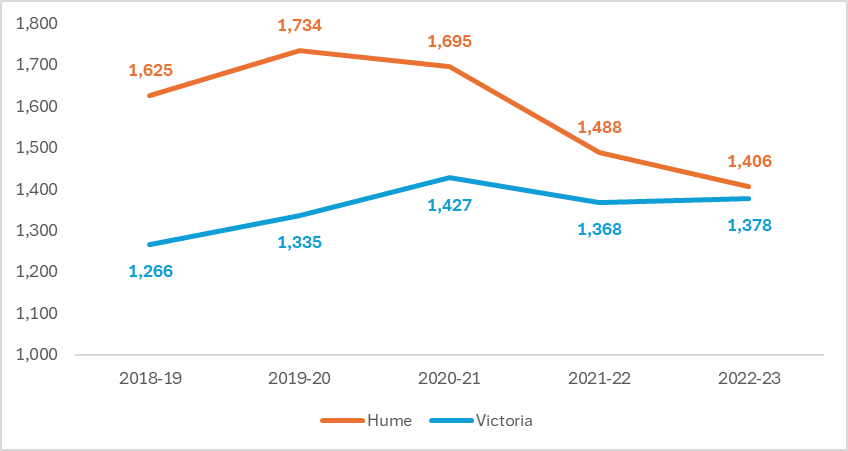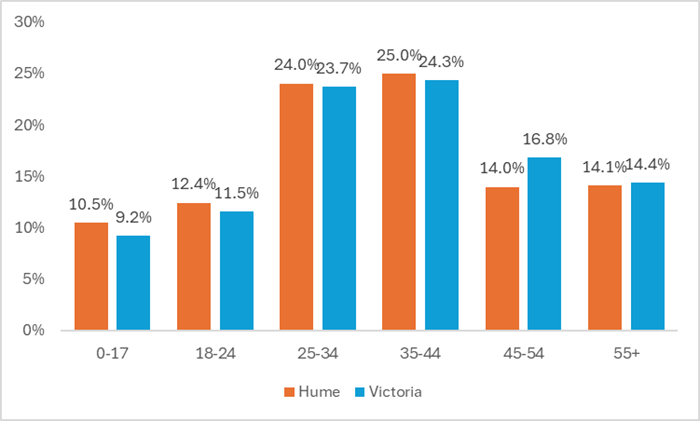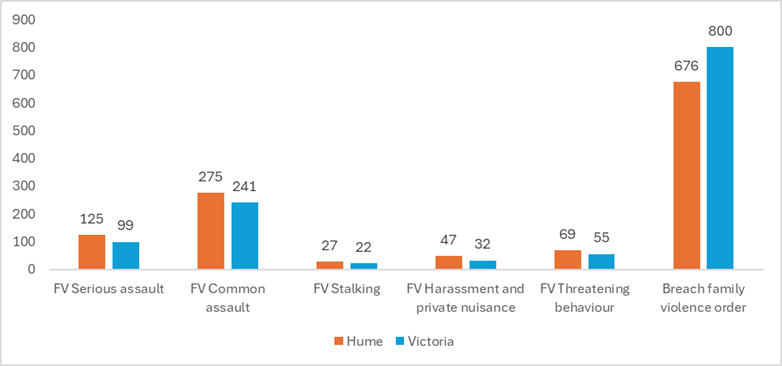In 2022-23 Hume City recorded 3,641 incidents of family violence, with an incident rate of 1,406 per 100,000 population, slightly higher than the Victorian rate of 1,378. Family violence incidents included in this rate are those which required attendance by Victoria Police (though may not be criminal events) and where police identified that there was a familiar relationship between the individuals involved. Since 2019-20, the rate of family incidents in Hume City has been declining. Hume City currently has the fourth highest rate of family incidents per 100,000 population across Greater Melbourne.
The most common form of abuse is verbal abuse, accounting for 40.0% of recorded abuse types. This is followed by emotional abuse (26.6%) and physical abuse (16.6%).
Family violence incidents - rate per 100,000 population

Affected family members of family violence incidents are most commonly aged between 25-44 years of age, with almost one in two (49.0%) affected family members in this age group. Hume City has a higher proportion of younger persons as affected family members compared to Victoria. This is consistent with Hume’s younger age profile and high rates of family households with children. Approximately 75% of affected family members in family violence incidents in Hume are female, the same as the Victorian average.
In just over two out of five (42.6%) recorded incidents of family violence in Hume City, a child was present as either a victim or a witness. This is higher than the statewide rate of 36.7%.
Family violence incidents 2022-23 – Affected Family Member age group

Criminal Offences Relating to Family Violence
Almost one in four (23.2%) criminal offences in Hume City in 2022-23 related to family violence incidents. The most common offences were breach of a family violence order (41.7%) and family violence related common assault (17.0%). The rates per 100,000 population of family violence related offences in Hume City are slightly higher in Hume City when compared to Victoria (with the exception of breach of family violence order).
Family violence recorded offences – rate per 100,000 population 2022-23

Sexual Offences
Sexual offences include rape, indecent assault, and other acts of a sexual nature against another person, which are non-consensual or where the person is deemed incapable of giving consent because of youth or temporary or permanent incapacity. In Victoria, sexual violence is overwhelmingly perpetrated by men against women, About one third of reported sexual offences are related to family violence. In 2021-22 sexual offences in Hume City occurred at a rate of 10.4 per 10,000 people for females and 1.5 for males. Both rates are slightly lower than the Victorian averages (13.6 and 2.3 respectively).
Elder Abuse
Local level data on elder abuse is not available, however, a 2021 Australian study by the Australian Institute of Family Studies found that one in six older people experience elder abuse. An older person is defined as being over 65 years (or over 50 for Aboriginal and Torres Strait Islander people). The number of older people who experience abuse is likely higher as older people are often reluctant to report abuse. The most common types of elder abuse are financial abuse, physical abuse, sexual abuse, psychological (emotional) abuse and neglect.
Socio-demographic characteristics associated with an increased likelihood of experiencing elder abuse include being separated, divorced or never married, having stepchildren, owning a home with a mortgage or renting (including living in public housing), and or living in a disadvantaged area. Experiences of elder abuse are associated with poorer physical health, poorer psychological health and a lower sense of social connection.